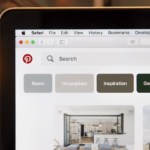Pinterest is a powerful tool for generating new traffic and leads. It’s where people find great products, inspiration, and solutions to needs.
Brands and businesses can connect with their customers organically on Pinterest. Research shows it’s one of the most effective marketing platforms available:
- 478 million people use Pinterest monthly to find ideas and inspire their next purchase.
- 97% of Pinterest searches are unbranded.
- 85% of Pinners say Pinterest is where they start a new project.
- 80% of weekly Pinners have discovered a new brand or product on Pinterest
- Your content’s lifespan on Pinterest is four months to forever compared to 48 hours on Instagram or 15 minutes on Twitter.
If Pinterest is such a great place for brands and businesses to market their products, why do many struggle with it? Most brands aren’t utilizing Pinterest in the right way. They treat it as a social media platform when it’s really a visual search engine. They don’t map out their customer journeys from pin to product, making them miss the conversion opportunity.
What Brands Do Wrong
Companies might want to invest in Pinterest marketing to send new traffic to their website and generate leads. However, they fail to do so because they treat Pinterest like a social media platform.
Unlike social media, Pinterest requires a particular kind of content. It must engage users and encourage them to click through. It has to inspire them to save a pin or repin it to one of their own boards. To do that, brands must create pins strategically. This means choosing the right images and writing good copy.
In addition, brands fail to create a marketing strategy specifically for their target audience on Pinterest. Without a clear goal (like increasing traffic to your website or gaining a certain number of followers on the platform), you’ll see inconsistent results.
How To Energize Your Brand’s Pinterest Account
Avoid common errors brands make on Pinterest to breathe life into your account. Here are a few tips to optimize your Pinterest account.
#1. Create a Pinterest business account.
You can’t take full advantage of the opportunities on Pinterest using a personal account. Switch to a business account, then do the following:
- Claim your website
- Link your Pinterest to any other social media accounts you have
- Enable and set up Pinterest Rich Pins
- Install the Pinterest tag on your website—even if you don’t want to start with Pinterest ads immediately, the tag will still record your website visitors.
#2. Reflect your brand on your page.
Think of your Pinterest account as an extension of your website and content. That means your brand image should be clear and easily identifiable. This includes your name, name, logo, cover photo, and pin designs.
#3. Identify your ideal audience.
To create an effective strategy, you need to know exactly to whom you’re targeting your content. Your audience on Pinterest might be different from your audience on social media. The reason people follow you on Instagram, for example, might be different from why they look for you on Pinterest. Do some keyword research, test your pins, and try to figure out the following:
- What keywords does your target audience look for
- Solutions for their problems or needs
- Why they’re on the platform
#4. Know your keywords.
Since Pinterest is technically a visual search engine, Pinterest SEO is key. This means integrating relevant keywords. Prepare a list of keywords pertinent to your product or service, your ideal audience, and probably the season (if that’s relevant to your brand). Find them through the Pinterest search bar and on the Pinterest Trends page.
Once you find them, use your keywords EVERYWHERE: on your profile, your boards, your pin title, and your descriptions.
#5. Create keyword-driven boards.
Start by creating 5-8 boards relevant to who you are, what you do, or the products you sell. Use keywords in both the board title and board description.
If you already have boards, clean up and delete ones irrelevant to your brand. Don’t mix your personal boards with your business ones. Keep your personal pins in a separate personal Pinterest account.
#6. Start pinning!
Now that you’ve set up your profile and boards and are ready to go, it’s time to post pins. Here are some tips to follow to get more traffic to your pins:
- Your pins should be vertical (9:16 ratio)
- Include a text overlay or a call to action
- Include your brand name
- Link to a product page or a blog post located on your website
- The pin title and description should be filled with keywords. The description shouldn’t feel like a robot wrote it. Make it flow naturally, as if someone is talking and describing the pin.
Just like any other platform, using new features to gain more exposure helps, as early adopters are always rewarded. Pinterest released story pins in 2020 in the US. They’re now called Idea Pins and available to everyone, so make sure to use them!
Pinterest is currently experimenting with LIVES. It’s only available in the US now, so take advantage of them if you have access.
#7. Be consistent.
If you only post occasionally, your Pinterest will stagnate. Be consistent with your content, and your traffic will be much more likely to grow.
Revive Your Account Today
Posting on Pinterest can be a powerful marketing strategy if used correctly. If you’re not getting the results you deserve on Pinterest, try these tips to boost your traffic and get your account back on track. You never know what will work until you try it!
Author Bio: Sandy Dedeian founded Rectified Inc., a digital marketing firm based in Montreal. Since 2004, she has worked with multiple SMEs in Canada, the USA, the UK and the Middle East to help them maximize the impact of their marketing efforts. She holds an MBA from HEC Montreal.





